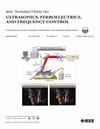Synthetic Versus Classic Data Augmentation: Impacts on Breast Ultrasound Image Classification
IF 3.7
2区 工程技术
Q1 ACOUSTICS
IEEE transactions on ultrasonics, ferroelectrics, and frequency control
Pub Date : 2025-03-01
DOI:10.1109/TUFFC.2025.3566340
引用次数: 0
Abstract
The effectiveness of deep neural networks (DNNs) for the ultrasound image analysis depends on the availability and accuracy of the training data. However, the large-scale data collection and annotation, particularly in medical fields, is often costly and time consuming, especially when healthcare professionals are already burdened with their clinical responsibilities. Ensuring that a model remains robust across different imaging conditions—such as variations in ultrasound devices and manual transducer operation—is crucial in the ultrasound image analysis. The data augmentation is a widely used solution, as it increases both the size and diversity of datasets, thereby enhancing the generalization performance of DNNs. With the advent of generative networks such as generative adversarial networks (GANs) and diffusion-based models, the synthetic data generation has emerged as a promising augmentation technique. However, comprehensive studies comparing classic and generative method-based augmentation methods are lacking, particularly in ultrasound-based breast cancer imaging, where variability in breast density, tumor morphology, and operator skill poses significant challenges. This study aims to compare the effectiveness of classic and generative network-based data augmentation techniques in improving the performance and robustness of breast ultrasound image classification models. Specifically, we seek to determine whether the computational intensity of generative networks is justified in data augmentation. This analysis will provide valuable insights into the role and benefits of each technique in enhancing the diagnostic accuracy of DNN for breast cancer diagnosis. The code for this work will be available at: ht.tps://github.com/yasamin-med/SCDA.git合成与经典数据增强:对乳腺超声图像分类的影响。
深度神经网络(dnn)在超声图像分析中的有效性取决于训练数据的可用性和准确性。然而,大规模的数据收集和注释,特别是在医疗领域,往往是昂贵和耗时的,特别是当医疗保健专业人员已经承担了临床责任的负担。在超声图像分析中,确保模型在不同的成像条件下(如超声设备和手动换能器操作的变化)保持鲁棒性是至关重要的。数据增强是一种广泛使用的解决方案,因为它增加了数据集的大小和多样性,从而提高了深度神经网络的泛化性能。随着生成对抗网络(GAN)和基于扩散的模型等生成网络的出现,合成数据生成已成为一种有前途的增强技术。然而,缺乏比较经典和基于生成方法的增强方法的综合研究,特别是在基于超声的乳腺癌成像中,乳房密度、肿瘤形态和操作员技能的可变性构成了重大挑战。本研究旨在比较经典和基于生成网络的数据增强技术在提高乳腺超声图像分类模型的性能和鲁棒性方面的有效性。具体来说,我们试图确定生成网络的计算强度是否在数据增强中是合理的。该分析将为每种技术在提高DNN诊断乳腺癌诊断准确性方面的作用和益处提供有价值的见解。这项工作的代码可以在https://github.com/yasamin-med/SCDA.git上找到。
本文章由计算机程序翻译,如有差异,请以英文原文为准。
求助全文
约1分钟内获得全文
求助全文
来源期刊
CiteScore
7.70
自引率
16.70%
发文量
583
审稿时长
4.5 months
期刊介绍:
IEEE Transactions on Ultrasonics, Ferroelectrics and Frequency Control includes the theory, technology, materials, and applications relating to: (1) the generation, transmission, and detection of ultrasonic waves and related phenomena; (2) medical ultrasound, including hyperthermia, bioeffects, tissue characterization and imaging; (3) ferroelectric, piezoelectric, and piezomagnetic materials, including crystals, polycrystalline solids, films, polymers, and composites; (4) frequency control, timing and time distribution, including crystal oscillators and other means of classical frequency control, and atomic, molecular and laser frequency control standards. Areas of interest range from fundamental studies to the design and/or applications of devices and systems.

 求助内容:
求助内容: 应助结果提醒方式:
应助结果提醒方式:


